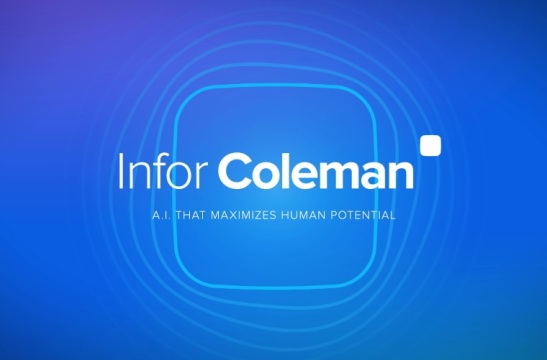Infor lays out plans for artificial intelligence and cloud-based business intelligence and analytics. Here’s what customers need to know.
Infor entered the increasingly crowded artificial intelligence (AI) arena July 11 by introducing its Coleman AI platform. Unveild at the company’s Inforum 2017 event in NY, Coleman was described as a language- and image-savvy AI platform that will automate rote tasks and augment human capabilities in a range of industry-specific use cases. Infor also used Inforum to detail its plans for Brist, the cloud-based business intelligence platform acquired in April.

Named for ’60-era NASA data scientist Katherine Coleman Johnson, one of three African American NASA mathematicians portrayed in the 2016 film “Hidden Figures,” Coleman builds on Infor assets including machine learning capabilities for retail acquired with Predictix and the work of the company’s Dynamic Science Labs. The labs have developed apps including a price optimization app for distributors and an inventory optimization app for healthcare providers.
Existing apps and machine learning capabilities are being folded into the Coleman portfolio, and Infor says it’s also well along in developing a unifying data platform for AI. Built on Amazon Web Services infrastructure, including an Amazon S3 data lake, the platform will aggregate petabytes of data available from Infor’s various industry-focused CloudSuites. The data will fuel AI-powered optimization, recommendation, and decision-automation services that will be delivered through Infor’s Ion API-integration platform.
Infor will use the speech recognition and natural language understanding capabilities of the Amazon Lex AI service to power conversational capabilities. This will enable Coleman to serve as a human assistant, answering questions such as, “Coleman, what are the payments outstanding for company X,” or “Coleman, forecast demand for product Y.” Conversational UIs will also support multi-faceted processes with simple requests such as, “Coleman, approve the promotion of Sara Jones.”
With image-recognition capabilities, Coleman will turn smart phone cameras into search tools. Take a picture of a product, for example, and Coleman will be able to identify the product and detail prices, specifications and availability details. Used internally, Coleman will tell workers how much inventory is available, what’s on order, when it will arrive and whether alternatives are available from other suppliers.
MyPOV on Coleman Vision vs. Reality
Infor certainly offered a compelling AI vision, but executives also acknowledged that it’s “early days” for Coleman. Data-pipeline development and modeling is further along in some industries than others, they acknowledged. Smart services for retail are likely to arrive first. As for the ingredients of Coleman, it’s a mixed collection of Infor and third-party IP. It remains to be seen just how it will all come together and when we’ll start seeing smart prediction, recommendation, optimization, and automation services beyond what existed before Coleman was announced.
I’m particularly eager to understand how and whether Infor uses generalized models based on aggregated CloudSuite data and then develops customer-specific recommendations and smart services. With its recent Leonardo launch, SAP talked about combining shared models and customer-specific models. Customers will also want to know whether it’s as simple as “turning Coleman on” from within a CloudSuite, as Infor executives suggested. We have also yet to learn just how much data will be required to generate reliable predictions, recommendations, optimization and automated actions.
Infor’s Birst Acquisition and Plans for Analytics
When Infor announced the acquisition of Birst in April, the first question for customers of the cloud-based BI company was, “will Birst disappear as an independent company?” The answer was an emphatic no. Birst operations continue unchanged under the direction of the existing management team. Birst founder and CEO, Brad Peters, continues as General Manager of what’s now known as “Birst, an Infor Company.”
The first question for Infor customers was, “how will Birst work with my existing Infor BI investments, including Cognos-based reporting tools and Infor BI cubes?” The company laid out detailed integration plans at Inforum.
In the first phase of the three-phase plan, currently underway, Infor customers can swap out like-for-like capabilities that they’ve licensed from Infor for newer, cloud-based capabilities from Birst. For example, customers using Infor’s Cognos-based reporting tools can switch to reporting tools available from Birst. They’ll also be able to add capabilities, at extra cost, that weren’t available from Infor, such as Birst’s ETL engine and self-service data-exploration and visualization capabilities.
Infor has already integrated Birst with Infor Ming.le collaboration and single-sign-on capabilities, but phase two, expected to be completed in September, will bring even deeper levels of integration. For example, customers using Infor BI will be able to use Birst as a cloud-based environment for analysis and reporting. This will enable Infor customers to leverage their Infor BI cubes while also blending in external data sources and taking advantage of Birst’s modern data-exploration and visualization capabilities. Integration is also underway between Infor’s Amazon S3- and Athena-based data lake environment and Birst. This will extend Birst’s big data analysis capabilities.
In phase three, Birst will add predictive capabilities from Infor’s Dynamic Science Labs unit. We’ll also see deeper integration of Birst-powered analytic services into the Infor XI platform as well as ties to Coleman AI services. The delivery date for phase three was unspecified.
MyPOV on Birst Integration
Infor is doing its best to preserve existing customer investments while providing an upgrade path to newer and more extensive Birst capabilities. On the reporting front there’s not a migration path for existing operational reports, so customers will likely gradually phase out existing tools supporting legacy reports while building new reports on Birst. The deeper and more significant value is in Infor BI, so it’s a big win for customers to see those cubes integrated with Birst’s cloud-accessible, self-service analytical environment. Overall, Birst brings significant upgrades to Infor’s analytics layer that will help support the company’s move into big data and artificial intelligence.
Related Reading:
SAP Machine Learning Plans: A Deeper Dive From Sapphire Now
Oracle Launches Adaptive Intelligent Apps for CX
Qlik Plots Course to Big Data, Cloud and ‘AI’ Innovation


